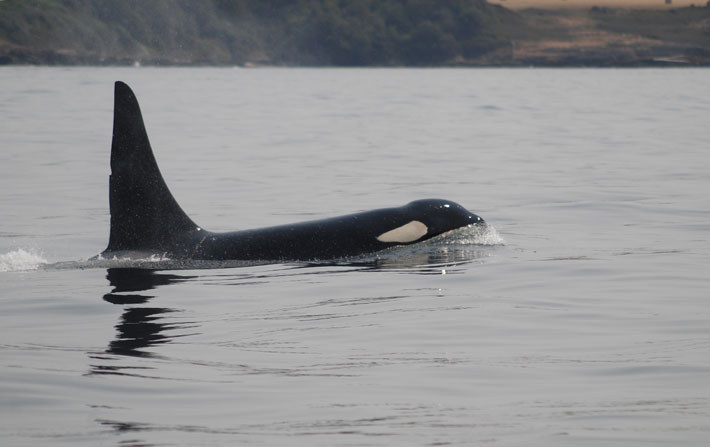Photo by J. Gaydos
Killer whales (Orcinus orca) are a charismatic species and a Pacific Northwest icon. The SeaDoc Society has been involved in killer whale research since the organization started. We have helped to identify sources of toxins in killer whales, led the creation of a plan to keep killer whales out of oil spills, and have vastly improved our knowledge about diseases that can impact killer whale recovery.
All of these efforts are emblematic of SeaDoc's approach to science and to ecosystem restoration and wildlife protection.
Keeping killer whales out of oil spills
When NOAA Fisheries identified that an oil spill was a huge risk for the Endangered southern resident killer whale population, they knew they had to create a contingency plan for keeping whales out of an oil spill if it were to happen and they looked to SeaDoc to help make this plan.
In the 1989 Exxon Valdez disaster in Alaska, two pods of killer whales were decimated. One has just recently started to recover; the other is probably headed for extinction. Before that disaster, people thought killer whales would be able to stay out of spilled oil. The Exxon Valdez proved that wasn't the case.
In 2007, SeaDoc partnered with NOAA to bring together a group of killer whale experts and spill response professionals from the US and Canada to discuss how killer whales could be kept out of a major spill.
Over the course of the two-day workshop, the participants discussed the effects of oil on cetaceans, killer whale mortality from the Exxon Valdez event, permit issues, risk assessments, response coordination, availability of equipment, pre- and post-event monitoring, and techniques for hazing animals to keep them away from oiled areas.
The result is that we are much more prepared to save whales’ lives in the event of a catastrophic spill. The response plan for keeping killer whales out of a spill is now part of the Northwest Area Contingency Plan, which is the region's go-to manual for dealing with an oil spill. Responders now have techniques and equipment ready to put into action.
SeaDoc’s work on killer whales and oil spills is a good example of how we bring people together to solve tough issues, especially issues that involve both sides of the international border that splits the Salish Sea.
Unraveling the mystery of killer whale diseases
Disease can be as important as predation when shaping populations and ecosystems. However, when the southern resident killer whale population was listed by the Canadian and US Federal governments, very little was known about how diseases could impact killer whale recovery. SeaDoc published the first comprehensive paper on diseases of killer whales, identifying which ones were of greatest concern when recovering populations in decline.
This study was a good first step, but showed us that we really knew very little about killer whale diseases. In an attempt to learn more, SeaDoc partnered with NOAA and Dr. Steven Raverty at UBC to create the first ever protocol designed to help responders gather as much information as possible from stranded killer whales.
This protocol, which was revised and reissued in 2014, has been widely used and has helped stranding responders maximize the amount of information learned from every carcass. Thanks to this protocol and to dedicated funding from NOAA to analyze samples, since 2004 scientists have performed necropsies on 1 out of every 3 killer whales that strand in the North Pacific – a remarkable 1600% increase in effort. The data collected – on causes of death, contaminants, and genetics - are already being used to help recover endangered killer whale populations.
In 2014, SeaDoc lead a study to identify killer whale stranding trends from as far back as 1925.
Understanding toxins in killer whales
The high levels of persistent organic pollutants in killer whales has been identified as an important cause for their decline and reason for their slow recovery. We knew that these contaminants came from the salmon that resident killer whales ate, but didn't know whether those contaminants got into salmon locally or when they grew out in the Pacific Ocean before returning to spawn. SeaDoc funded Drs. Peter Ross, Donna Cullon and others to study this. They found that that 97 to 99% of polychlorinated biphenyls (PCBs), polychlorinated dibenzo-p-dioxins (PCDDs), polychlorinated dibenzofurans (PCDFs), dichlorodiphenyltrichloroethane (DDT), and hexachlorocyclohexane (HCH) in adult chinook salmon (resident's favorite prey item) were acquired during their time at sea and not from the Salish Sea. This study also found that southerly chinook salmon stocks had a lower fat content, meaning that this could cause southern resident killer whales to increase their salmon consumption by as much as 50%, which would further increase their exposure to these contaminants.
SeaDoc's work on killer whales is a good example of how we identify areas where good scientific information is missing, and then structure projects that can fill those gaps. In the case of the necropsy protocol, a relatively small amount of effort has resulted in a much more substantial increase in our knowledge about what is happening to this important species.
Support SeaDoc's innovative projects
Private donations from people like you provide most of the support we use to help create a healthier Salish Sea.
Please consider making a donation to support the Salish Sea wildlife you care about.


